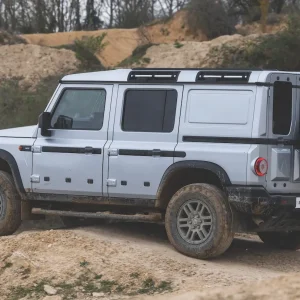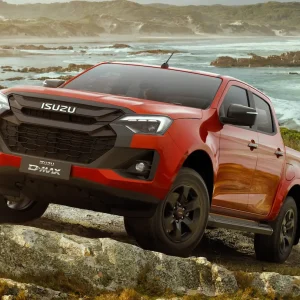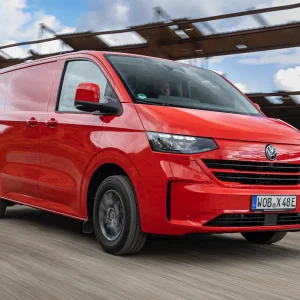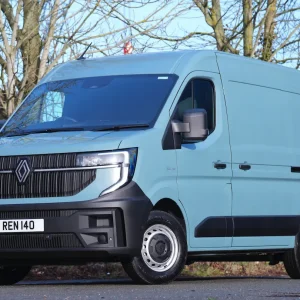Final Report
I have now bid a fond farewell to my Multivan, which has been reluctantly returned to Volkswagen HQ in Milton Keynes following a five-month stint on the What Van? fleet during which it impressed its principal drivers, my wife Jenny and myself, as a consummately smooth and accommodating operator.
Jenny is not always thrilled to get behind the wheel of a hefty LCV but had no such qualms when it came to piloting the Multivan, in fact we frequently found ourselves squabbling over who should claim the keys.
In truth, the Multivan proved itself to be less like a big van to drive and more like a top-end MPV, the high-up driving position complemented by good all-round vision and a comfortable seat that offers the driver ample adjustability to find their ideal perch point.
Despite its name and the fact it is sold through VW Van Centres, the Multivan is not strictly speaking a van at all as it is built on the MQB platform that produces the Volkswagen’s passenger cars as well as the Caddy Cargo compact van.
I quickly became aware this versatile and sophisticated vehicle was an advancement in technology and quality compared to the Transporter-based Caravelle it replaced and could be a sensible choice for businesses needing to transport executives in comfort and style. Its versatility means it can also serve as the family people carrier outside of working hours while converting into a capable load-lugger with the second and third row seats removed.

The Multivan boasts an airy, roomy interior. I opted for the version with six seats: two up front, two in the middle and two in the rear, but customers can specify seven with an extra one in the back row. Volkswagen’s decision to resist squeezing in more seats adds to the sense of luxuriant spaciousness. Leg and shoulder room is never likely to be an issue for even the largest passengers, although the rear passenger seats themselves are on the dinky side. The seats behind the cabin in the Multivan can be moved forwards and backwards on rails and also removed to free up storage space. Unlike in its predecessor, the Caravelle, however, the middle row seats cannot be swivelled around, so if you do want to turn them around to face the rear seats to create a meeting space, you have to physically remove them and place them back on their rails in the opposite direction. The second and third row of seatbacks recline and are equipped with Isofix for fitting child seats.
Accessing the rear pair of seats proved to be easy with the middle seats able to slide well forward. The centrepiece in the interior is the central console that slides from the front two seats to the rear and, at the push of a button, raises up and transforms into a full-height multifunction table that also provides cup holders and discreet stowage space for small items.
With all seats in place there was a 763-litre up-to-the-roof load space in the boot of my long Multivan. Remove the middle and rear seats in the Long version and you get a generous cargo space of more than 4.0m3 and a loading length of 2,425mm.
On the occasion I removed the rear seats to free up space prior to visiting a recycling centre, however, I found they were heavy for an individual to lift out and, coupled to the fact the Multivan has no bulkhead to protect the front-row occupants from items that may hurtle forward under heavy braking, I would conclude it is better suited to carrying people than goods.
Handling and performance are both commendable for a big vehicle and the ADAS installed is also impressive. I was particularly enamoured with the adaptive cruise control that, apart from making long journeys far more relaxing and less energy sapping will slow the Multivan to a standstill in busy traffic and start the wheels moving again from 0mph.
End-of-term report
Performance = 4/5
Impresses in all driving environments, only let down by high urban fuel consumption.
Load carrying = 3/5
The Multivan is a useful cargo carrier but better suited to luxury passenger transport.
Interior = 4/5
A well thought-out interior provides a versatile space for executive meetings or travelling in comfort.
Desirability = 5/5
For executive transport with lashings of corporate comfort the Multivan is hard to beat.
Driver aids = 4/5
Choc full of ADAS to make life both easier and safer.
Volkswagen Multivan Style Long 2.0-litre TSI 204hp 7spd DSG
Mileage 11,784mls
Official combined fuel economy 31.4mpg
Our average consumption 24.5mpg
Price range (ex VAT) £43,160–£59,515
Price (ex VAT) £48,145
Warranty 3yrs/100,000mls
Service intervals 25,000mls
Load length (with rear seats removed) 2,425mm
Load width 1,312mm
Load bay height 1,312mm
Load volume (with seats removed) 4.0m3
Gross payload 704kg
Engine size/power 1,984cc/204hp
Gearbox 7-spd DSG
CO2 204g/km
4th Report
During its time on the What Van? fleet, the Volkswagen Multivan has proven its worth both as a versatile and luxurious people carrier and also, when called upon, as an effective load lugger.
But what’s it like for the person sitting behind the steering wheel?
I have now driven the Multivan in a variety of settings including city streets, A roads, B roads, motorways and country lanes, and the overall impression is favourable.
With many new, battery-powered vans coming to market and with the vast majority of light commercial vehicles on the road being diesel, it stands to reason that most of the LCVs What Van? reviews are either electric or oil burners.
It makes a change, therefore, to spend so much time in a petrol-propelled vehicle such as the Multivan. One of the main differences compared to a diesel van is the much wider span in fuel consumption between urban and extra-urban driving.
Out on the open road, the Multivan turns in mpg figures up in the high 30s but in busy city traffic this can fall to around 15mpg, despite the presence of a stop/start system that takes a while to kick in, particularly in cold weather. In a diesel van the gap between high and low consumption environments would be far narrower.

The driving experience itself is of a high standard across the board. With 204hp available there is always ample power on tap, meaning the Multivan can more than hold its own in the fast lane of the motorway. While VW’s seven-speed DSG transmission may have been around for a long time, it still stands up well against newer arrivals on the market, although Ford’s ten-speed auto installed in the Transit has raised the bar.
The steering is on the light side but reassuringly accurate, there is never a sense the Multivan will not travel in the direction you point it, even when pushed quite hard.
Having said that, as befitting a vehicle of this size, the drive is relaxing and comfortable rather than dynamic, which makes me wonder why VW bothered to install gear shift paddles on either side of the sporty-looking, multifunction steering wheel. Far more useful and frequently used are the armrests on both sides of the driver’s seat. The front seat passenger and those in the second row of seats get them too. Heated front seats go without saying but particularly welcome during the March cold snap was the heated steering wheel, activated by a button on said steering wheel.
The Multivan is equipped with a wealth of ADAS to make life safer and easier for driver and passengers. Along with the likes of Side Assist with rear traffic alert, all-round sensors and an excellent rear view camera, the Multivan features adaptive cruise control and VW’s Travel Assist, which takes it some way towards autonomous driving by controlling speed, distance to the vehicle in front and even the steering function, although if the driver does not keep at least a light grip on the wheel a message soon appears in the dashboard reminding them to do so. Most of these systems work well and are without doubt helpful but I did find a stretch of the M3 with temporarily narrowed lanes succeeded in confusing the Lane Assist function.
The Park Assist function, activated by a button on the dashboard, finds parking spaces and then takes over the steering, leaving the driver to control brakes and accelerator, as it manoeuvres into the space. Aside from its initial novelty value this is useful in urban situations, although I have found the sensors can be prone to identify what it thinks are perpendicular spaces as well as parallel spaces in busy city streets when only the latter are available.
Report card: Performance = 4/5
The Multivan impresses in all driving environments, the only downside being high fuel consumption in the city.
Volkswagen Multivan Style Long 2.0-litre TSI 204hp 7spd DSG
Mileage 11,506mls
Official combined fuel economy 31.4mpg
Our average consumption 24.9mpg
Price range (ex VAT) £43,160–£59,515
Price (ex VAT) £48,145
Warranty 3yrs/100,000mls
Service intervals 25,000mls
Load length (with rear seats removed) 2,425mm
Load width 1,312mm
Load bay height 1,312mm
Load volume (with seats removed) 4.0m3
Gross payload 704kg
Engine size/power 1,984cc/204hp
Gearbox 7-spd DSG
CO2 204g/km
3rd Report
I have already marvelled at the Multivan’s versatility in terms of being able to carry seven, or in my case, six people in considerable comfort, as well as having the capacity to be transformed into an executive meeting space replete with full-height, multifunction table that also provides storage compartments and cup holders, but what is it like when it comes to the more prosaic task of lugging loads?
I recently put it to the test during a mission carting a variety of garden waste and household goods to a south east London recycling centre.
Many such local authority centres, which cater for private households rather than commercial businesses, do not allow access to vans but shape shifting is one of the Multivan’s chief selling points and, although it is sold through Volkswagen’s van network, it can also be classified as a people-carrying MPV.
Before loading up the Multivan, I first had to create its cargo space, which can be accessed via the rear tailgate without having to unlock the cabin or sliding side doors. The second and third row of seats sit on rails to enable them to be moved back and forward and the central console (table) sits on a track in the centre, which allows it to be moved from between the rear seats to the cabin. You can remove the console and all the seats if necessary.

Looking at the assortment of stuff I had to get in, my first step was to collapse the table top, lower the central console and slide it forward to between the driver’s and front passenger’s seats.
Next, I elected to take out the rear two seats. This is accomplished by pulling the red strap at the bottom of the seat back and lifting the seat out of the tracks. Although Volkswagen insists the individual rear seats weigh less than they did in the Caravelle, they still make quite a heavy burden for one person to shift, so it’s advisable to be parked close to where you’re going to stow them before removing them from the vehicle.
Wary of jolting my back, I decided it wasn’t necessary to remove the second row of seats, so lowered the seat backs by tugging the black strap and slid them forward to nestle behind the front two seats. I then covered up the folded seats as well as the floor of the interior with dust sheets to protect the carpet lining.
Preparations complete, I loaded up and found that, with a loading length of 2,625mm, the Multivan Long was well able to accommodate an old dining table top as well as providing ample space for table legs, camping mattresses and several bags of chopped-down bamboo.
Without a bulkhead to protect the cabin it is, of course, essential to make sure that nothing will come loose in transit and to take extra care while driving. The excellent Auto Hold system, which prevents the vehicle from rolling backwards or forwards without the
driver having to keep pressing the foot brake or apply the parking brake, helps in this regard.
Report card: Load carrying = 3/5
The Multivan is a useful cargo carrier but better suited to luxury passenger transport.
Volkswagen Multivan Style Long 2.0-litre TSI 204hp 7spd DSG
Mileage 10,865mls
Official combined fuel economy 31.4mpg
Our average consumption 25.1mpg
Price range (ex VAT) £43,160–£59,515
Price (ex VAT) £48,145
Warranty 3yrs/100,000mls
Service intervals 25,000mls
Load length (with rear seats removed) 2,425mm
Load width 1,312mm
Load bay height 1,312mm
Load volume (with seats removed) 4.0m3
Gross payload 704kg
Engine size/power 1,984cc/204hp
Gearbox 7-spd DSG
CO2 204g/km
2nd Report
As its name would suggest, the Multivan’s USP is its versatility. If you were just in the market for a light commercial with the capacity to carry extra bodies, you could just opt for a crew van or the seven- or nine-seat versions of medium vans; a Renault Trafic Passenger, for example,
On the other hand, if you’re after a car with more seats together with enhanced comfort and refinement then you might go shopping for a high-end MPV like the Mercedes-Benz V-Class.
The Multivan straddles both camps. It offers an airy, roomy interior and oozes sophistication. It comes with six or seven seats and I opted for the former: two up front, two in the middle and two in the rear. Volkswagen’s decision to resist squeezing in more seats adds to the sense of luxuriant spaciousness. Leg and shoulder room is never likely to be an issue for even the largest passengers, although the seats themselves are on the dinky side. If you’re looking for something more akin to a minibus then the aforementioned Renault or the mid-size Stellantis nine-seat derivatives of the Citroën Dispatch, Peugeot Expert or Vauxhall Vivaro might be more up your street, or if you’re a Volkswagen diehard then the Transporter Shuttle would be worth a look.

The seats behind the cabin in the Multivan can be moved forwards and backwards on rails and also removed to free up storage space. Unlike in its predecessor, the Caravelle, however, the middle row seats cannot be swivelled around, so if you do want to turn them around to face the rear seats to create a meeting space, you have to physically remove them and place them back on their rails in the opposite direction. The seats are lightweight though, and with the help of a release strap this is a fairly simple procedure. The second and third row of seatbacks recline and it’s good to see they are all equipped with Isofix for fitting child seats.
Accessing the rear pair of seats is easy enough with the middle seats sliding well forward. The pièce de résistance in the inside of the Multivan is the central console that slides from the front two seats to the rear and at the push of a button raises up and transforms into a full-height multifunction table that also provides cup holders and discreet stowage space for small items.
The table is likely to be well used because the fold down trays on the backs of the front and middle seats seem to be too flimsy to trust with anything heavier than a sandwich.
With all the seats in place there is a 763-litre up-to-the-roof load space in the boot of my Long Multivan and the load area is divided by a handy shelf that is easy to remove.
There is also plenty of space in the central aisle between the seats for more luggage.
Take out the middle and rear seats in the Long version of the Multivan and you are presented with a generous cargo space of more than 4.0m3 and a loading length of 2,425mm.
Report card: Interior = 4/5
A well thought-out interior provides a versatile space for executive meetings or travelling in comfort.
Volkswagen Multivan Style Long 2.0-litre TSI 204hp 7spd DSG
Mileage 10,623mls
Official combined fuel economy 31.4mpg
Our average consumption 33.5mpg
Price range (ex VAT) £43,160–£59,515
Price (ex VAT) £48,145
Warranty 3yrs/100,000mls
Service intervals 25,000mls
Load length (with rear seats removed) 2,425mm
Load width 1,312mm
Load bay height 1,312mm
Load volume (with seats removed) 4.0m3
Gross payload 704kg
Engine size/power 1,984cc/204hp
Gearbox 7-spd DSG
CO2 204g/km
1st Report
The ID. Buzz Cargo may be grabbing the lion’s share of the headlines, but sitting beside it in the Volkswagen Commercial Vehicles’ line up is another highly sophisticated vehicle: the new Multivan.
The Multivan replaces both the Sharan MPV and the Transporter-based Caravelle in the Volkswagen range and as its name suggests, it’s versatile.
Strictly speaking, it is not a straight-up commercial vehicle as it is spawned by the MQB platform that rolls out the manufacturers’ passenger cars as well as the Caddy Cargo compact van. The Multivan could be seen as a rival to top-end MPVS, such as the Vauxhall Vivaro Life, Mercedes-Benz V-Class or even the BMW X7 but as an indication of where Volkswagen places it in the market, if you want to try one out you’ll have to go to a VW Van Centre rather than to one of the brand’s car dealerships.
Volkswagen Commercial Vehicles offers the front-wheel drive only Multivan with four powertrains, including, for the first time in a VWCV model, a plug-in hybrid engine. The Multivan eHybrid pairs a 1.4 TSI petrol 150hp engine with an 85kW electric motor to produce power output of 160kW (218hp). VWCV claims it has a pure electric range of up to 50km (31 miles). The eHybrid is married to a six-speed DSG gearbox and the electric charging point is located on the right-hand side of the front wing.
The Multivan is also available with two four-cylinder turbocharged petrol engines: a 1.5 TSI 136hp and a 2.0 TSI 204hp unit, which is the one I opted for.
A 2.0 150hp four-cylinder turbo diesel joined the range last year and these engines are all twinned with the brand’s long-serving seven-speed DSG gearbox.
The Multivan’s 3,124mm wheelbase supports two lengths, Standard and Long, which is the one tested here. The longer version has a low-slung, stretched out appearance but, like its shorter sibling, seats up to seven occupants. The long version measures 5,173mm bumper to bumper.
Multivan prices range from about £43,000 for the 1.5 TSI 136hp Life model to more than £60,000 for the 1.4 TSI eHybrid 218hp Energetic model with long wheelbase.
Specification on the entry-level Life model includes 16in alloys, seven seats, two sliding doors with power latching, the Digital Cockpit plus 10in infotainment system and front assist and lane assist its standard items.
Style models, which start at circa £58,000 for the SWB 2.0 TSI 204hp model, introduce the IQ.LIGHT LED matrix headlights, the Discover Media navigation system, park assist, electric sliding doors and tailgate with easy open feature, and 17in alloys.
The special edition Energetic is available only with the 1.4 TSI eHybrid 218hp powertrain. Additions include a Harmon Kardon sound system, privacy glass, 18in alloys, and panoramic glass roof.
First impressions are that the Multivan has made a big step up compared to the Caravelle and could make a compelling choice for businesses needing to transport executives in comfort and style. Its versatility means it could also serve as the family people carrier outside of working hours while converting into a capable load-lugger with the second and third row seats removed.
Report card: Desirability = 5/5
For executive transport with lashings of corporate comfort the Multivan is hard to beat.
Volkswagen Multivan Style Long 2.0-litre TSI 204hp 7spd DSG
Mileage 9,797mls
Official combined fuel economy 31.4mpg
Our average consumption 24.1mpg
Price range (ex VAT) £43,160–£59,515
Price (ex VAT) £48,145
Warranty 3yrs/100,000mls
Service intervals 25,000mls
Load length (with rear seats removed) 2,425mm
Load width 1,312mm
Load bay height 1,312mm
Load volume (with seats removed) 4.0m3
Gross payload 704kg
Engine size/power 1,984cc/204hp
Gearbox 7-spd DSG
CO2 204g/km
Options (prices ex VAT)
Discover Pro navigation and infotainment system including ‘Streaming & Internet’ £235
Six seater package – two single seats in 3rd row and two single seats in 2nd row £0





